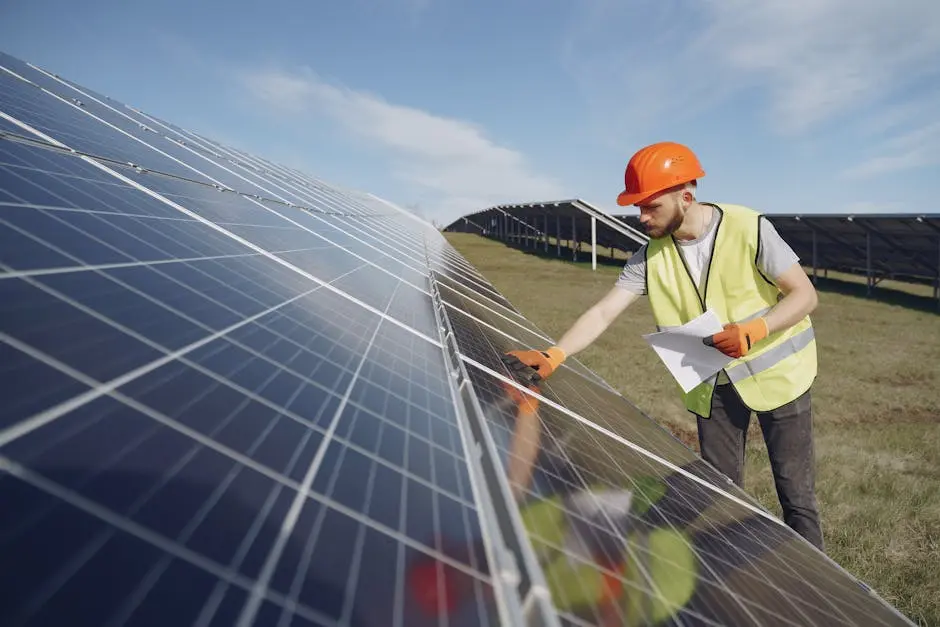Solar energy has emerged as a popular solution for those seeking to reduce their energy bills and contribute to a sustainable environment. But beyond the environmental benefits, solar savings can significantly impact your financial independence. Let’s explore how adopting solar technology can be a smart financial decision.
Understanding the Basics of Solar Savings
To effectively explore solar savings, it’s crucial to grasp the fundamental concept of how solar energy works. Solar panels capture the sun’s energy and convert it into electricity for your home. This shift from traditional power sources not only reduces energy bills but also paves the way for long-term savings.
Solar savings start with the basic principle of solar power generation, which essentially involves harnessing sunlight and converting it into usable electricity. Photovoltaic panels, typically installed on rooftops, play a key role in this process. They contain photovoltaic cells made from silicon that act as semiconductors. When sunlight strikes these cells, it knocks electrons loose from their atoms, generating a flow of electricity. This basic understanding forms the foundation of how solar panels work and gives insight into the savings potential they hold.
Beyond the science of energy conversion, understanding solar savings also requires knowledge of how solar systems are connected to the electrical grid. Most residential solar setups are grid-tied, meaning they are connected to the local utility’s power supply. This setup allows homeowners to use solar power generated during the day and draw from the grid when their solar production is insufficient, such as at night or on cloudy days. Additionally, any excess electricity produced can be sold back to the utility, often through a process called net metering, further enhancing savings.
The Financial Benefits of Going Solar
Investing in solar panels offers several financial benefits. Firstly, by generating your own electricity, you can significantly lower your monthly utility bills. Additionally, many regions offer tax incentives and rebates for solar installation, making the initial investment more manageable. Over time, the savings on energy costs can outweigh the upfront expenses.
The financial advantages of going solar extend beyond just monthly bill reductions. Many governments and local municipalities provide attractive incentives to encourage solar adoption. For instance, federal tax credits can cover a substantial percentage of installation costs, significantly reducing the financial burden on homeowners. In states with high electricity rates, the monthly savings on utility bills can be particularly substantial, resulting in a quicker return on investment. Consequently, these incentives can make solar power a financially appealing option.
Another attractive aspect of solar savings is the potential increase in property value. Homes with solar installations are often seen as more desirable, and studies suggest they can sell faster and at higher prices. Buyers are increasingly aware of the long-term savings associated with solar energy, and this awareness translates into a willingness to pay a premium for homes equipped with solar panels. Therefore, investing in solar not only cuts ongoing expenses but also adds value to the home, contributing to long-term financial benefits.
Assessing Your Energy Needs
Before making the jump to solar, it’s important to assess your household’s energy needs. Understanding your current energy consumption can help you determine the size and capacity of the solar system required. This evaluation ensures you invest in a system that meets your needs and maximizes your savings potential.
A thorough assessment of your energy needs involves examining your household’s historical energy usage. Start by reviewing past electricity bills to determine your average monthly and annual consumption. Consider factors such as home size, number of occupants, and energy-intensive appliances like air conditioners or electric vehicles if applicable. This information helps in sizing your solar system appropriately to optimize efficiency and ensure that your investment aligns with your energy goals.
Exploring Financing Options
A common concern when considering solar is the initial cost. Fortunately, various financing options are available, such as solar loans, leases, and power purchase agreements (PPAs). Each option has its pros and cons, so it’s important to research and choose the one that aligns with your financial situation and goals.
Solar loans are a popular choice for those looking to own their solar system outright. Similar to traditional loans, they entail borrowing a sum of money to cover the upfront costs of the solar array. The homeowner then repays the loan over time with interest. The advantage is that, upon repayment, the homeowner enjoys the full benefits of solar savings without any further financial obligations to third parties.
Alternatively, solar leases and power purchase agreements (PPAs) provide options for those hesitant about upfront costs. With a lease, a company installs solar panels on your property and you pay a fixed monthly fee to use the energy produced. PPAs are similar but instead charge based on the actual energy generated. These agreements typically involve less initial cost and maintenance responsibility; however, the long-term savings are often lower than those achievable through outright ownership.
Calculating Your Return on Investment
Calculating the return on investment (ROI) for solar installation involves considering factors like energy savings, tax credits, and the lifespan of the solar panels. While the initial cost might seem high, the long-term savings and potential increase in property value contribute to a compelling ROI for many households.
Key to understanding ROI is accounting for all potential savings and income streams. Start by determining the total cost of your solar system, including installation and potential maintenance expenses. Next, factor in local utility rates to calculate your potential annual savings on electricity bills. Include any applicable state and federal tax incentives to Offset initial investment costs. Finally, take into account the expected lifespan of your solar panels, typically around 25 years, to estimate the duration of savings and returns.
Moreover, incorporating variables like energy cost inflation and advancements in solar technology can provide a more comprehensive view of long-term ROI. Energy prices have historically trended upwards, which means the savings derived from generating your own power increase as utility costs rise. Additionally, if efficiency and technology innovations continue as they have, your solar system could yield even better performance over time, enhancing your returns further.
Harnessing Solar Power for Energy Independence
Ultimately, the goal of switching to solar is to achieve a level of energy independence. By relying less on traditional energy sources, homeowners can protect themselves from rising energy costs and enjoy a more stable financial future. Embracing solar technology is not just an investment in your home—it’s an investment in your financial well-being.
Energy independence means more than just financial savings; it encompasses security and peace of mind. With solar power, homeowners are less susceptible to external energy market fluctuations and political disruptions that can affect electricity prices. Generating power locally ensures a consistent supply and enhances resilience against unexpected power outages, strengthening both financial and operational stability.
It’s important to view solar power not just as a means to escape rising costs but as a catalyst for sustainable living. By reducing reliance on fossil fuels and minimizing carbon footprints, homeowners contribute to a cleaner and more sustainable future. As energy independence becomes a bigger motivator, the role of solar power in achieving these goals becomes even more critical. Taking steps towards solar adoption today is an investment that transcends personal financial gains, supporting broader environmental sustainability and societal resilience.
Achieving Financial Independence with Solar
As solar technology becomes more accessible and affordable, the opportunity to achieve financial independence through solar savings is within reach for many. By understanding the financial benefits and considering your long-term energy needs, you can make an informed decision that not only supports your financial goals but also contributes to a cleaner, greener planet.

















